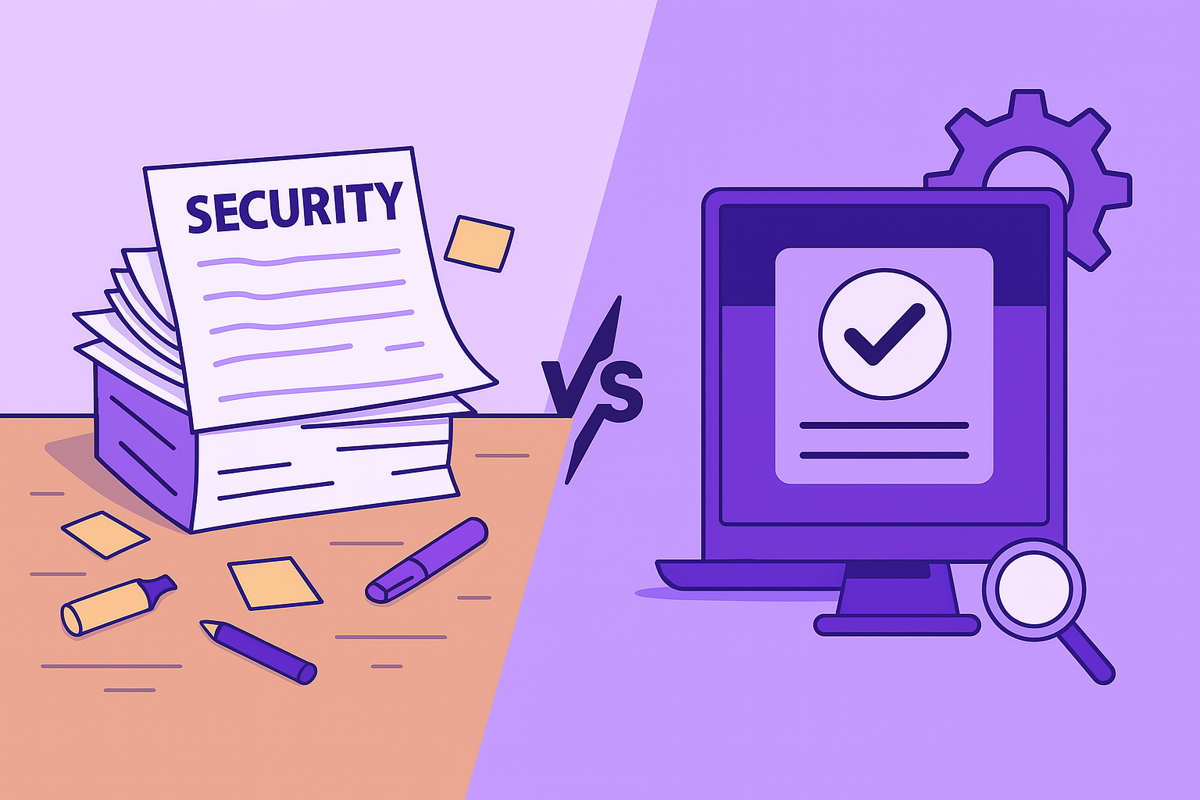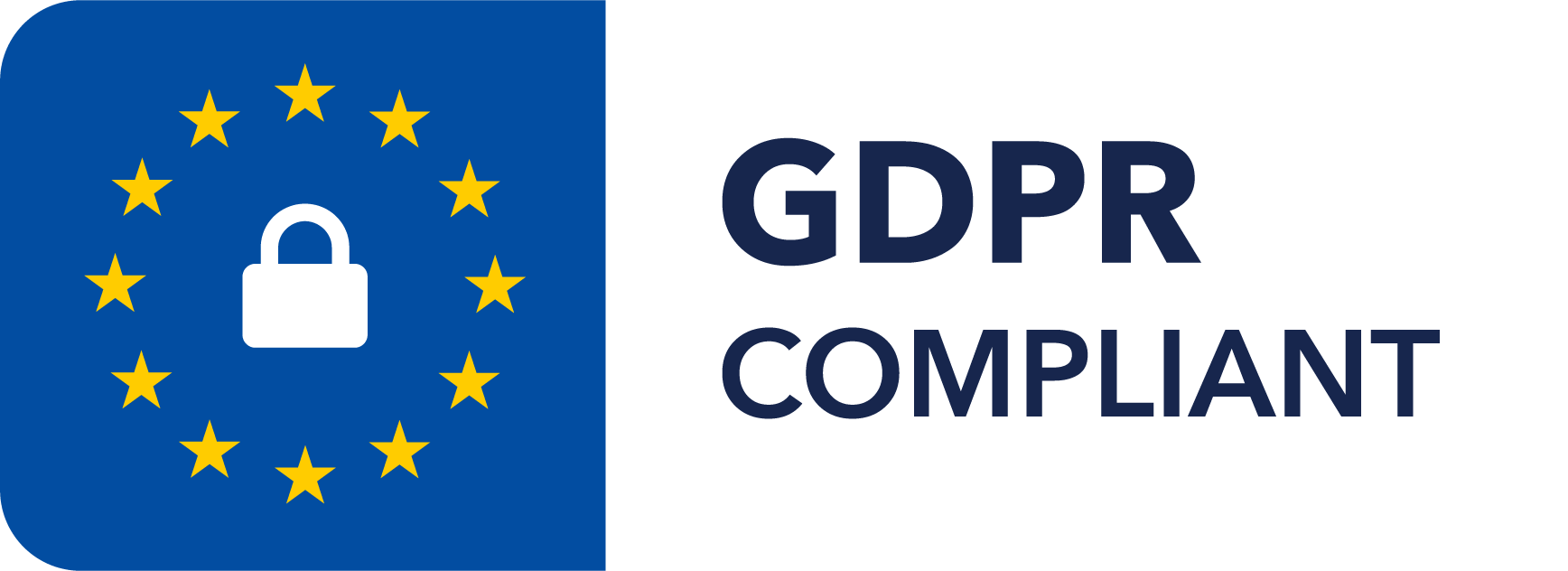4 Key Benefits of Automating Security Questionnaires
July 9, 2025
By
Evie Secilmis

Your security experts are your company's first line of defense against real threats. So why are they spending half their week answering the same questions for the sales team? The manual process of completing security questionnaires turns your most strategic minds into administrative assistants. This isn't just inefficient; it's a misuse of critical talent. The benefits of automating security questionnaire responses go far beyond just saving time. It’s about freeing your experts to focus on actual security work and transforming a repetitive chore into a streamlined, intelligent process with security assessment automation software.
First, What Is a Security Questionnaire?
If you're in B2B sales, you've likely encountered a security questionnaire. It might feel like just another piece of paperwork standing between you and a closed deal, but it’s a critical step for your potential customer. At its core, a security questionnaire is a formal process for a company to verify that its vendors—that’s you—have solid security practices in place. Think of it as a due diligence checklist that helps them manage third-party risk. Before they integrate your product or service into their operations, they need assurance that you won’t introduce a security vulnerability into their ecosystem. It’s a fundamental part of building trust and showing that you’re a responsible partner who takes data protection seriously.
The Purpose: Verifying Vendor Security
The main goal of a security questionnaire is to create a standardized way to evaluate a vendor's security posture. When a business works with a new partner, they need to make sure that partner won't put their sensitive data at risk. These questionnaires serve as a test, asking detailed questions to confirm that your security measures are up to par. It’s a proactive step that helps your prospective clients avoid data breaches and other security incidents that could originate from their supply chain. By providing clear, accurate, and thorough answers, you demonstrate your commitment to security and help your customer feel confident in their decision to work with you, making the entire process smoother for everyone involved.
Meeting Compliance Standards (SOC 2, ISO 27001)
You'll often find that security questionnaires are built around established industry frameworks. Many questions are designed to verify your adherence to standards like SOC 2 or ISO 27001. These frameworks provide a common language for security and compliance, so when a customer asks if you're SOC 2 compliant, they're really asking if you meet a specific, recognized standard for managing customer data. Aligning your security practices with these standards not only makes it easier to complete questionnaires but also gives you a significant competitive advantage. It shows prospects that your security program is mature, well-documented, and has been validated against globally accepted best practices, which can speed up the procurement process significantly.
Key Security Topics Covered
Security questionnaires cover a wide range of topics to get a complete picture of your security environment. You can expect questions about your company’s security governance, risk management processes, and data handling procedures. They often get into the specifics of your technical controls, asking about things like data encryption methods, both for data at rest and in transit. Other common areas include application security, threat management protocols, incident response plans, and how you manage employee access to sensitive information. The goal is to leave no stone unturned, ensuring your client has a comprehensive understanding of how you protect their data and maintain the integrity of your services.
The Problems with the Manual Process
While security questionnaires are a necessary part of doing business, the traditional, manual approach to completing them is often a source of major frustration. It’s a process that can quickly become a bottleneck, involving multiple departments from sales and legal to IT and security. Team members spend countless hours digging through old documents, spreadsheets, and emails, trying to find the right answers. This scavenger hunt for information is not only inefficient but also pulls highly skilled experts away from their primary responsibilities. What should be a straightforward step in the sales cycle can turn into a disorganized, time-consuming ordeal that puts pressure on everyone involved and slows down business growth.
It Slows Down the Sales Cycle
For sales teams, time is money, and nothing kills momentum like a deal getting stuck in a security review. When a security questionnaire lands in your inbox, the clock starts ticking. The manual process of finding subject matter experts, waiting for their input, and compiling answers can take days or even weeks. According to research from SafeBase, security teams often spend hours just copying and pasting answers and searching through old files. This delay directly impacts the sales cycle, pushing back timelines and creating uncertainty. A slow response can be perceived as a lack of preparedness, potentially causing a prospect to lose confidence and consider a competitor who can move faster.
It Wastes Your Security Experts' Time
Your security and IT experts are some of your most valuable resources, responsible for protecting your company from genuine threats. Yet, the manual questionnaire process often turns them into administrative assistants. Instead of focusing on strategic security initiatives, they are bogged down with the repetitive task of answering the same questions over and over again for different prospects. As your company grows and the volume of questionnaires increases, this problem becomes unsustainable. According to TrustCloud, it's nearly impossible to handle this workload manually without a significant increase in headcount. This inefficient use of expert time is not just costly; it also takes them away from the critical work that keeps your organization secure.
Inconsistent Answers Erode Trust
When multiple people are responsible for answering security questions, consistency is one of the first casualties. Your sales engineer might describe a security control one way, while an IT manager describes it slightly differently. These small discrepancies can add up, leading to inconsistent or even contradictory information being sent to prospects. Inconsistent answers can raise red flags during a security review, making your company appear disorganized or, worse, untruthful. This erodes the trust you're trying to build with a potential customer. A centralized, single source of truth for all your security information is essential for presenting a professional and trustworthy image every single time.
Tracking Updates is Nearly Impossible
The manual process of managing security questionnaires is a project manager's nightmare. With responses scattered across emails, shared drives, and local documents, there's no clear visibility into the status of a questionnaire. It's difficult to know which questions have been answered, who approved the responses, or if the information being used is even up-to-date. This lack of a central system makes collaboration chaotic and version control a guessing game. A disorganized process not only adds stress and inefficiency but also increases the risk of submitting outdated or unapproved information. Having a platform with clear features for tracking progress and managing content is key to overcoming this challenge.
What Does Security Questionnaire Automation Actually Do?
Security questionnaires are essential tools used by companies to assess the security posture of their vendors and partners. These questionnaires can be lengthy and complex, often requiring input from various departments. Automation tools simplify the process by automating repetitive tasks, such as data collection and analysis, allowing teams to focus on more strategic activities.
The Role of Artificial Intelligence (AI)
So, what’s the secret sauce behind the most effective automation tools? It’s artificial intelligence. AI takes automation a step further than simple scripts or macros. Instead of just performing a pre-programmed task, AI can understand context, interpret questions, and generate human-like responses. When applied to security questionnaires, AI acts as a brilliant assistant for your team. It intelligently sifts through your company’s vast library of security information to find the most relevant details, drafts accurate answers based on that approved content, and presents it in the right format. This isn't just about speeding up a process; it's about making the entire workflow smarter, more consistent, and significantly less of a drain on your expert resources.
AI-Powered Answer Generation
One of the biggest time sinks in the questionnaire process is writing answers from scratch. AI-powered platforms completely change this dynamic. The technology can analyze the questions in an incoming questionnaire—whether it’s in a spreadsheet, a Word document, or a PDF—and understand what’s being asked. It then generates precise, well-written answers using your organization's approved information. Platforms like HeyIris can produce a complete first draft in minutes, not hours. This allows your security and sales teams to shift their focus from tedious writing to strategic review and refinement, ensuring every response is not only fast but also perfectly accurate and on-brand.
Rapid Information Retrieval from a Single Source of Truth
How much time does your team waste digging through old emails, shared drives, and chat messages to find the last approved answer to a question about data encryption? AI eliminates this frustrating scavenger hunt. An AI-powered system centralizes all your security documentation—past questionnaires, internal policies, compliance certificates, and more—into a single, searchable knowledge base. This becomes your single source of truth. When a question comes in, the AI instantly scans this repository to find the correct information. Some advanced systems can even proactively identify and flag outdated content across your connected systems, ensuring your source of truth stays current and trustworthy.
Handles Multiple Questionnaire Formats
Every customer seems to have their own preferred format for security questionnaires. One might send a 500-row Excel file, another a formatted Word document, and a third might require you to fill out a clunky online portal. Manually transferring information between these formats is tedious and invites copy-paste errors. Modern AI automation platforms are designed to be format-agnostic. They can ingest and process various file types, extracting questions and populating answers regardless of the layout. This flexibility removes a major administrative headache, allowing your team to focus on the quality of the answers, not the logistics of filling out the form.
Why Automate Security Assessments?
Automating security assessments offers numerous benefits:
- Efficiency: Automation reduces the time required to complete assessments by eliminating manual tasks. Teams can generate comprehensive reports quickly and accurately.
- Consistency: Automated tools ensure that assessments are conducted uniformly, reducing the risk of human error and ensuring compliance with industry standards.
- Scalability: As organizations grow, the number of vendors and partners also increases. Automation tools can easily scale to handle a larger volume of assessments.
- Cost-Effectiveness: By minimizing manual labor, organizations can reduce the costs associated with conducting security assessments.
Drastically Reduce Response Time
Let’s be honest, the manual process of answering security questionnaires is a major time sink. Your team has to hunt down subject matter experts, dig through old documents, and manually copy-paste answers, all while the sales clock is ticking. Automation completely changes this dynamic. Instead of days or weeks, an AI-powered platform can generate a complete first draft in minutes. It does this by creating a centralized knowledge library of all your approved answers. When a new questionnaire comes in, the tool instantly finds and populates the best responses, freeing your team to focus on strategic review and customization rather than tedious administrative work. This speed is a game-changer for any sales cycle, helping you get back to prospects faster and keep deals moving forward.
Improve Risk Management
Speed is great, but accuracy is critical. Sending out inconsistent or outdated security information can erode trust and even put your company at risk. An automated system acts as your single source of truth, ensuring every response is consistent, accurate, and pre-approved by your security and compliance teams. As noted by security experts, automation software can "automatically spot and flag security risks, helping businesses fix them before they become big problems." Some platforms, like Iris, take this a step further by proactively identifying when information in your knowledge base becomes outdated. This ensures you’re not just answering quickly, but you’re always presenting the most current and correct security posture, which is essential for maintaining compliance and building trust with potential partners.
Enhance the Customer Experience
The way you handle a security assessment is a direct reflection of your company's professionalism and efficiency. A slow, disorganized response can make a potential customer question your ability to deliver on your promises. Conversely, providing a swift, thorough, and professional response builds confidence from the start. When clients receive "fast, reliable answers, which builds trust and helps close deals faster," it sets a positive tone for the entire business relationship. By automating this process, you demonstrate that your organization is organized, secure, and easy to work with. This improved experience can become a significant competitive differentiator, as seen in various customer success stories where streamlined processes led to stronger partnerships.
Handle Information More Securely
There's a certain irony in emailing sensitive security information back and forth in unsecured spreadsheets. This common practice exposes your company’s confidential data to unnecessary risks like phishing attacks or simple human error. Automation platforms provide a much safer alternative. By design, these tools offer a secure, centralized environment for storing and managing all your sensitive documentation and responses. Instead of relying on email, everything is contained within a system built with security in mind. This approach ensures that your "sensitive documents are kept in a secure system, not sent through risky emails," which minimizes the chance of a data breach and proves to your prospects that you take vendor security seriously.
What to Look For in Security Questionnaire Automation Software
When choosing a security questionnaire automation tool, it is essential to consider the features that will best meet your organization's needs. Here are some key features to look for:
A Central Knowledge Base
Think about how much time your team spends hunting for answers. They're digging through old emails, searching shared drives, and messaging subject matter experts for information they know exists somewhere. A top-tier automation tool eliminates this chaos by creating a single source of truth. This central knowledge base stores all your approved answers, security documentation, and compliance certificates in one organized place. When a new questionnaire comes in, the system can instantly pull the correct, up-to-date information. This not only saves countless hours but also ensures consistency across all your responses, which is key for building trust with potential customers. Your team can then focus on tailoring responses and managing the relationship, not on tedious data collection.
Proactive Security Portals
What if you could answer a customer’s security questions before they even ask? That’s the idea behind a proactive security portal. Some automation platforms help you create a public-facing page where you can share your security posture, certifications like SOC 2 or ISO 27001, and answers to frequently asked questions. By making this information easily accessible, you can build trust with prospects early in the sales process. This transparency can significantly reduce the number of security questionnaires you receive, as potential clients can often find what they need on their own. It shows you’re confident in your security practices and helps shorten sales cycles by removing a common roadblock before it even appears.
Seamless Integration with Your Workflow
The best software for security questionnaire automation should seamlessly integrate with your existing systems and processes. Look for tools that offer compatibility with popular GRC (Governance, Risk, and Compliance) platforms and other security solutions.
Flexible Templates That Fit Your Needs
Every organization has unique security requirements. A good automation tool should provide customizable templates that allow you to tailor assessments to your specific needs.
Team Collaboration, Minus the Headaches
Collaboration is crucial when conducting security assessments. Choose a tool that enables real-time collaboration among team members, making it easier to gather input from various stakeholders.
Reporting That Gives You Clear Insights
Detailed reporting is vital for analyzing assessment results and making informed decisions. Look for tools that offer robust reporting features, including data visualization and export options.
How to Get Started with Security Questionnaire Automation
Implementing security questionnaire automation in your organization involves several steps:
- Assess Your Needs: Begin by evaluating your organization's security assessment requirements. Consider factors such as the volume of assessments, integration needs, and reporting preferences.
- Choose the Right Tool: Based on your needs assessment, select a security questionnaire automation tool that offers the features and capabilities your organization requires.
- Customize Templates: Tailor the tool's templates to align with your organization's specific security requirements.
- Train Your Team: Ensure that your team is familiar with the chosen tool and understands how to use it effectively. Provide training sessions and resources to facilitate a smooth transition.
- Monitor and Evaluate: Regularly monitor the performance of your automation tool and gather feedback from team members. Evaluate the tool's effectiveness and make adjustments as needed.
Train the AI with Your Existing Documents
An AI platform is only as smart as the information you give it. The first and most critical step is to train your automation software by feeding it your existing security documents. This includes everything from previously completed questionnaires and security policies to compliance certificates and technical documentation. By doing this, you’re not just uploading files; you’re building a centralized, intelligent knowledge base. This becomes your single source of truth, allowing the AI to instantly search across all your materials to find and formulate the most accurate answers. Think of it as giving a new, brilliant team member your entire library of institutional knowledge on day one. Platforms like Iris are built to ingest this information, making it immediately accessible and ready to use for any incoming request.
Assign Clear Ownership of the Process
Automation streamlines your workflow, but it doesn’t run itself. To make the process successful, you need to assign clear ownership. Designate a specific person or a small team to be the champions of your new system. Their responsibilities should include managing the software, ensuring the knowledge base stays current with the latest security updates, and serving as the final checkpoint before responses are sent. This accountability is crucial. Without a clear owner, even the best automation tool can become disorganized. Having someone oversee the process ensures that your answers remain consistent, accurate, and aligned with your company’s standards, preventing confusion and maintaining a high level of quality in your security communications.
Review and Personalize AI-Generated Answers
The biggest advantage of AI is its ability to generate a high-quality first draft in seconds, saving your team from the tedious work of hunting for information. However, the process shouldn't end there. A subject matter expert should always review the AI-generated responses. This human-in-the-loop step is essential for adding context, nuance, and personalization specific to the prospect asking the questions. This review ensures the tone is perfect and demonstrates that you’ve put genuine thought into your response, which helps build trust. Let the AI handle the heavy lifting of information retrieval and initial drafting, freeing up your experts to focus on the high-value task of refining and tailoring the final answer with powerful features that support collaboration.
Measure the Impact on Your Business
To understand the true value of security questionnaire automation, you need to track its impact. Start by establishing baseline metrics before you implement the tool, then measure your progress over time. Key performance indicators (KPIs) to watch include the average time to complete a questionnaire, the number of hours your security and sales teams spend on each response, and the percentage of questions the AI can answer without human intervention. You should also track the consistency of your answers and, ultimately, the effect on your sales cycle and win rates. This data provides concrete proof of your return on investment and helps you justify the technology to leadership, as shown in various case studies where teams have transformed their response processes.
Common Roadblocks and How to Clear Them
While automation offers numerous benefits, organizations may encounter challenges when implementing these tools. Here are some common challenges and solutions:
Keeping Your Data Safe and Private
Organizations must ensure that sensitive data collected during security assessments is protected. Choose a tool that offers robust security features and complies with data privacy regulations.
Solving Common Integration Puzzles
Compatibility with existing systems can be a concern. Work closely with your IT team to ensure seamless integration and address any technical issues that may arise.
Getting Your Team On Board
Team members may be resistant to adopting new tools and processes. Address these concerns by emphasizing the benefits of automation and providing adequate training and support.
Is Automation Right for Your Team?
Automation tools are revolutionizing the way organizations conduct security assessments. By streamlining the process, these tools enable businesses to efficiently manage security risks and maintain compliance. When choosing the best software for security questionnaire automation, consider your organization's specific needs and look for features such as integration capabilities, customizable templates, real-time collaboration, and comprehensive reporting. With the right tool in place, your organization can enhance its security posture and focus on strategic initiatives.
Frequently Asked Questions
Will AI take over the whole process, or do my experts still need to be involved? Not at all. Think of an AI platform as a brilliant assistant for your team, not a replacement. The goal is to eliminate the tedious, repetitive work of hunting for information and writing first drafts. Your security and IT experts are still essential for the final review. They can add specific context for the customer, personalize the tone, and give that final stamp of approval. This frees them from the administrative grind so they can focus on the strategic part of the process.
How much work is it to get an AI system like this up and running? Getting started is more straightforward than you might think. The initial step involves feeding the AI your existing documents, such as past questionnaires, security policies, and compliance reports. The platform does the heavy lifting of organizing this information into an intelligent knowledge base. While there's an initial effort to gather these materials, the time you save almost immediately makes it worthwhile.
Our company's security information is sensitive. How does an automation platform keep it safe? This is a critical point, and these platforms are built with security as a top priority. Using a dedicated automation tool provides a secure, centralized environment for all your confidential data. It's a significant improvement over the common practice of emailing unsecured spreadsheets back and forth, which exposes your information to unnecessary risks. The platform itself becomes a fortress for your security answers.
What's the real difference between using an AI platform and just keeping our answers in a shared spreadsheet? A shared spreadsheet is a static list of questions and answers that your team has to manually search through. An AI-powered platform is an intelligent system that understands the context of new questions. It can find the most relevant information from your entire library of documents, generate a precise answer, and even flag when content might be outdated. It actively helps you create the best response instead of just storing old ones.
Can a smaller team still get value from this, or is it only for large enterprises? Smaller teams can see some of the biggest benefits. When you have fewer people, you can't afford to have your experts spending half their time on administrative tasks. Automation acts as a force multiplier, allowing a small team to respond to security questionnaires with the speed and professionalism of a much larger company. It helps you compete effectively without needing to hire more staff just to handle paperwork.
Key Takeaways
- Stop misusing your top talent: The manual process of answering security questionnaires pulls your security experts away from critical work and slows down your sales cycle, creating unnecessary bottlenecks and frustration.
- Create a single source of truth: An AI-powered platform centralizes all your approved security information into one knowledge base. This eliminates the need to hunt for answers and ensures every response is consistent, accurate, and professional.
- Pair AI efficiency with human expertise: Let automation generate the first draft in minutes, freeing your team from repetitive tasks. Your experts can then focus on the high-value work of reviewing and personalizing the final responses to build trust and close deals faster.
Related Articles
- 9 Best Security Questionnaire Automation Software (2025)
- Security Questionnaires: The Ultimate Guide for Vendors
- Best Security Questionnaire Software to Automate Sales
Share this post
Link copied!



















